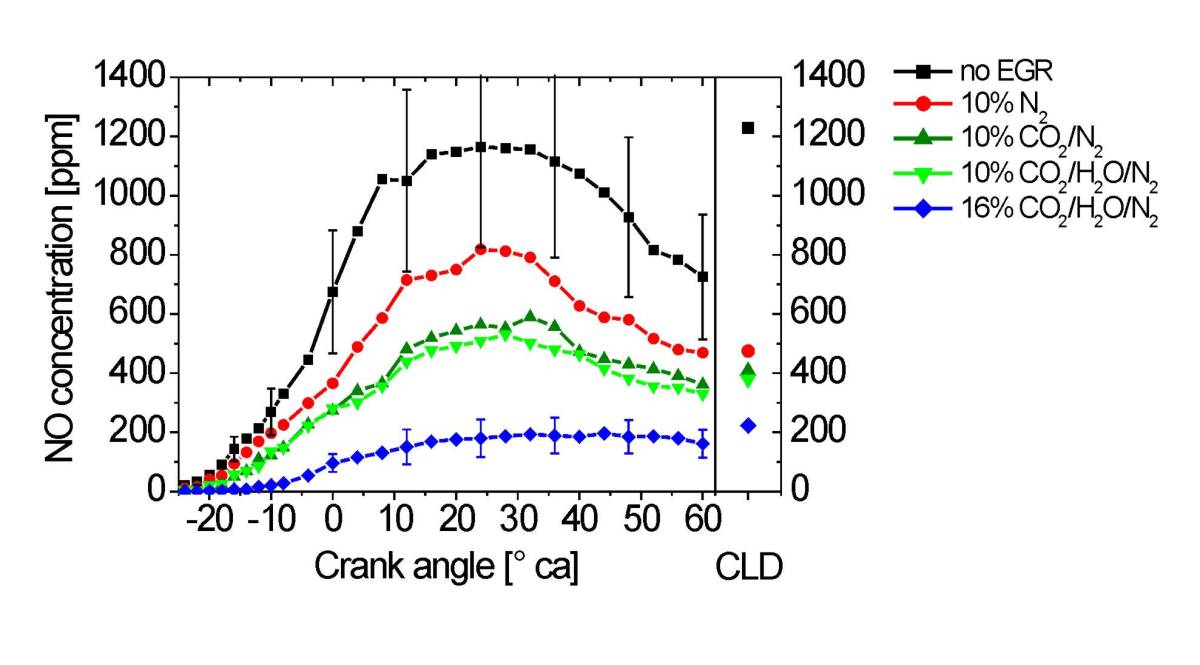Laser diagnostics in Combustion: IC Engine Diagnostic
Nitric Oxide Diagnostics
Detection of nitric oxide during combustion is of particular interest as NO is one of the most important combustion-generated pollutants. Automotive engines and gas turbines play a major role in the overall production of NO, which influences atmospheric ozone depletion and smog formation. In the future drastic regulatory restrictions on NO release are expected. Despite the use of catalytic converters for NO abatement, it is an important task to make engine exhaust cleaner.
To achieve this goal, it is necessary to understand how NO is formed during internal combustion. Laser-induced fluorescence (LIF) imaging is a diagnostic technique that allows non-perturbative investigation of in-cylinder NO formation. Laser and image-intensified cameras are able to acquire instantaneous images of the NO fluorescence with high temporal resolution. Fig. 1 shows the in-cylinder NO concentration field for different crank angle degrees in a direct-injected engine (BMW) [1]. For LIF measurements optical access is necessary; the engine was therefore equipped with silica windows in the cylinder wall and the piston.

Figure 1: Dependence of average NO concentration (left), single shot images (middle) and standard deviation (right) on crank angle position (left bottom). 0° crank angle corresponds to top dead center, i.e. upper position of the piston. Ignition was at 30° crank angle. The look-up table maximum corresponds to 1300 ppm NO concentration (left and middle) and 100% standard deviation (right).
In this engine the influence of exhaust gas recirculation (EGR) on NO formation was investigated. During EGR a part of the exhaust gas is recirculated to the fresh gases for the next combustion cycle. This causes a dilution of the reactive air/fuel mixture which reduces combustion temperatures. Because NO is mainly formed at high temperatures this leads to a reduction in NO formation. The LIF measurements provide insight in the quantity and mechanism of the NO reduction by EGR (fig. 2) [1].
EGR is being used in modern engines to reduce NO formation. This is however only possible to a certain degree, because combustion becomes increasingly unstable with increasing EGR, and emission of unburned hydrocarbons increases. Laser-based NO diagnostics will help develop new methods for the reduction of pollutants in future engine generations.
The quantitative interpretation of LIF intensities is based on spectroscopic properties, which are investigated systematically in High-Pressure experiments like flames, heated cells, and shock tubes. They are used for the further development of spectral simulation approaches.
References:
[1] W. G. Bessler, C. Schulz, M. Hartmann, M. Schenk, Quantitative in-cylinder NO-LIF imaging in a direct-injected gasoline engine with exhaust gas recirculation, SAE paper 2001-01-1978 (2001).
A choice of PCI publications on in-cylinder diagnostic
[2] G. Suck, J. Jakobs, S. Nicklitzsch, T. Lee, W. G. Bessler, M. Hofmann, F. Zimmermann, and C. Schulz, "NO laser-induced fluorescence imaging in the combustion chamber of a spray-guided direct-injection gasoline engine," SAE Technical Paper Series 2004-01-1918 (2004).
[3] F. Hildenbrand, C. Schulz, F. Keller, G. König, and E. Wagner, "Quantitative laser diagnostic studies of the NO distribution in a DI Diesel engine with PLN and CR injection systems," SAE Technical Paper No. 2001-01-3500 (2001).
[4] F. Hildenbrand, C. Schulz, J. Wolfrum, F. Keller, E. Wagner, Laser diagnostic analysis of NO formation in a direct injection Diesel engine with pump-line nozzle and common-rail injection systems, Proc. Combust. Inst. 28, 1137-1144 (2000).
[5] F. Hildenbrand, C. Schulz, M. Hartmann, F. Puchner, G. Wawrschin, In-Cylinder NO-LIF imaging in a realistic GDI engine using KrF excimer laser excitation, Society of Automotive Engineers, Tech. Paper Series, 1999-01-3545 (1999).
[6] C. Schulz, J. Wolfrum, and V. Sick, "Comparative study of experimental and numerical NO profiles in SI combustion," Proc. Combust. Inst. 27, 2077-2084 (1998).
[7] G. Josefsson, I. Magnusson, F. Hildenbrand, C. Schulz, and V. Sick, "Multidimensional laser diagnostic and numerical analysis of NO formation in a gasoline engine," Proc. Combust. Inst. 27, 2085-2092 (1998).
[8] F. Hildenbrand, C. Schulz, V. Sick, G. Josefsson, L. Magnusson, Ö. Andersson, M. Aldén, Laser spectroscopic invesitigation of flow fields and NO-formation in a realistic SI engine, SAE Technical Paper Series No. 980148 (1998).
[9] C. Schulz, V. Sick, J. Wolfrum, V. Drewes, M. Zahn, R. Maly, Quantitative 2D single-shot imaging of NO concentrations and temperatures in a transparent SI engine, Proc. Combust. Inst. 26, 2597-2604 (1996).
[10] C. Schulz, B. Yip, V. Sick, J. Wolfrum, A laser-induced fluorescence scheme for imaging nitric oxide in engines, Chem. Phys. Lett. 242, 259-264 (1995).

